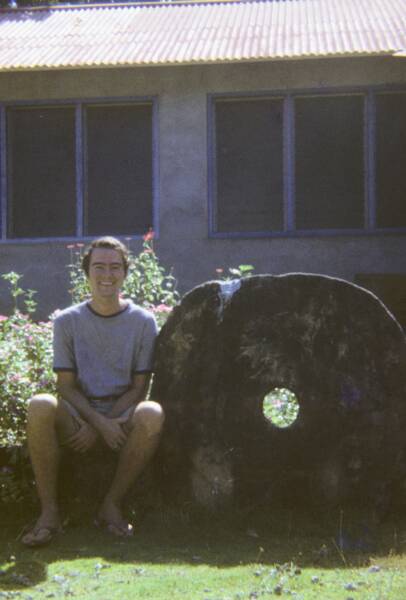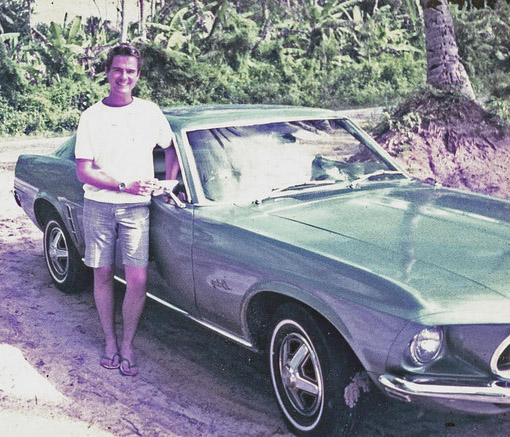Peace Corps Wimp
If you had asked me back at the beginning of the summer of 1968 if there was a single person among the hundreds of Micro 7 trainees less likely to become a Peace Corps Volunteer than I was, I would have looked at you in astonishment and said with my voice rising about two octaves, “Are you kidding?” I might even have offered to bet you just about any amount of money you cared to name that there wasn’t, because, the Law of Averages aside, I was pretty confident that no such person existed.
Don’t get me wrong. It’s not that I didn’t believe in the Peace Corps or in what the Peace Corps was trying to accomplish. It’s not that I wasn’t hard-working. Not that I didn’t want to meet new people, see new places, learn new things. It’s not that I didn’t want to help others if I could. Not that I didn’t think I could become a good teacher.
It’s just that I had never been very, well, outdoorsy, if you really want to know the truth. I’d never gone camping, never roughed it, never been without indoor plumbing a day in my life. What’s more—and this you might already have guessed—I was completely non-athletic. Completely. There were no letterman jackets hanging in my closet back home. No good times on the football field and the basketball court made up the best (or any) parts of my glorious memories of high school. I couldn’t even swim, despite being forced to take swimming two periods in a row for one whole year of college. As a matter of fact, as long as I’m being completely honest, I might as well go ahead and tell you that when they gave the test of physical ability on the very first day of that PE class, out of the 300 guys in the class, I scored Number 299. Number 299! The one guy who had less physical ability than I did, Number 300, was 5 feet 4 inches tall and weighed 370 pounds. Needless to say, he and I became the best of friends as we slogged through two years of PE hell together.
Not that either one of us ever did get one bit better at sports.
But the point I’m trying to make is this: when I say that, at the age of 23, I could have passed as the original Charles Atlas 90-pound weakling (135 actually, and none of it muscle), I’m not being modest or coy. It’s the honest-to-God truth. Look at the photograph up above on the right if you don’t believe me. That’s me my first year on Yap, sitting in front of the Delipebinaw Municipal Office in Kanif. You know what they say about photographs: “a thousand words” and all that. Well, if that photo tells you anything, it tells you beyond any possibility of doubt that I was a wimp. A cheerful wimp apparently, judging by the goofy grin; but a wimp nonetheless.
Which is why it should come as no surprise to you to hear that, during our training on Yap, I found certain aspects of the learning curve to be especially steep and, not to put too fine a point on it, daunting: trying, for example, to climb up onto the bed of the World War II-era dump truck that carted the kids from Delipebinaw and me to the high school every morning, without bruising, scraping, cutting, or stupidly killing myself; accepting the fact that the flies and cockroaches on the island outnumbered me by about a zillion to one and were not going to go away in my lifetime; stifling a scream and a stream of invective in broken Yapese followed by blazingly fluent English whenever a rat scrambled out of a bush and over my bare toes; regarding with equanimity the layer of mosquito larvae that floated on top of the water in the drum can outside my house, as I scooped coffee canfuls of water and larvae out and over my shivering body in my daily attempts to bathe. This last little aspect of the learning curve had a stratospheric "ick"-factor for me. I can’t tell you how many hours I spent trying to calculate the exact angle and speed of plunge it would take to get the maximum amount of water into the can with the minimum number of larvae.
I never did figure it out.
I should also tell you that I trudged and stumbled with no physical coordination whatsoever through the ankle-deep mud that seemed to materialize on the roads out of nowhere after every storm. And as for trying to walk on the stone paths that became diabolically slippery whenever it rained—which was, like, constantly—forget it. What a nightmare! I’m not saying I think the paths were out to get me, you understand; I’m not saying that at all. I’m just saying that my feet slid out from under me and I fell butt-first on those hard, wet stones so many times those first few months on Yap, it was difficult for me not to take it a little personally. And a whole lot painfully.
Nevertheless, while I was slipping and sliding and bumping and scraping and cursing and screaming and shivering and shaking my way through training, an odd thing happened: people in our group started to go home (“de-select themselves” is how the Peace Corps, ever diplomatic, put it). Over the course of the summer, 15—almost a third of the original 48 who made it through Escondido—packed their bags, said “Kafel” one last time, rode the Peace Corps Jeep out to the airfield, hopped the DC-6 to Guam, and winged their way eastwards to the loving arms of friends and family back in the good old US of A.
But here's something even odder: I wasn’t one of the 15 who left.
Instead, as unbelievable as it sounds, I actually completed training, passed my Final Boards, and on Saturday, the 24th of August 1968, joined the 32 remaining members of my group who were sworn in as Peace Corps Volunteers in the Yap District of the United States Trust Territory of the Pacific Islands.
I was dumbfounded by that unlikely turn of events and, at the same time, incredibly psyched.
When school started a week later, I had so many new students to teach and get to know, so much homework to correct and grade, so much preparation to do for the next day’s classes, there was almost no time left to fret about those worrisome things so dear to the heart of every wimp. In fact, I was usually so tired when I got home at night I had barely enough energy to give one brief shuddering thought to the rats dragging their evening snacks of water chestnuts back and forth across the bamboo rods that formed the ceiling of my little house, before collapsing onto my mat and plunging instantly into deep and dreamless slumber.
In time, there were improvements. I mastered the art of walking on wet stones without falling, and I learned to wade through mud with a semblance of geeky grace. I also managed to come to a live/let live arrangement with the fauna of the island (except for the fruit bats, which—I'm sorry to say—never did cease to totally creep me out). I stopped loathing the idea of mosquito larvae sluicing over my tender young body every morning. I mean, what was the point? I also stopped jumping out of my skin whenever a monitor lizard made a sudden guest appearance on the roadside as I was walking home, and I stopped screaming like a great big sissy banshee whenever a rat followed me into the benjo.
I wanted to scream, of course. But here’s the thing: I didn’t scream.
Over the months that followed, more of our group left for good, for one reason or another. As a result, by the end of our first year, fewer than half of us remained to complete our two-year commitment. But the funny thing is, it never occured to me to think of any of those Volunteers who went home early as wimps. I don’t know why. Maybe because they weren’t.
Still, I have to tell you, the very fact that they had left while I remained gave me a strange feeling of wimpish superiority. It's not a feeling I was proud of, by the way, either then or now; but it's a feeling I had nonetheless. Bad wimp.
The truth is, and you know this, like everyone else in the world, not all Peace Corps Volunteers are created equal. Some are better at the job than others. Some do parts of the job better than others. Some do parts worse. Sometimes circumstances make it impossible for some to do the job at all. That’s just the way it is.
In the two years that I lived on Yap, no one ever mistook me for the Poster Boy of Peace Corps Micronesia (although there were several guys in my group who could easily have filled that position, had there really been one). At the same time, no one ever mistook me for anything other than a Peace Corps Volunteer either. And that's something I really am proud of.
True, I never climbed a coconut tree. Never went fishing, never swam a stroke, never even saw an outrigger canoe, let alone sailed in one. I never danced with the men of my village (actually, I did dance with them two or three times, but I was so bad they stopped telling me about rehearsals). And I never walked past the Yap Islander when it was docked in Colonia without thinking, “It'll be a seriously cold day on the 9th Parallel before I ever set foot on that rusty old bucket of bolts!”
But here’s what I did do: I taught an awful lot of English to an awful lot of truly great kids. I met an amazing number of wonderful people who didn't care in the least that I was a wimp; they took me into their hearts and homes anyway, surrounded me with kindness and affection, and taught me more about life than I would ever have thought possible. I ate a lot and drank a lot and laughed a lot. I chewed an awful lot of betel nuts with an awful lot of friends. I had amazing experiences that even today remain undimmed in my memory.
I wish I could tell you that, thanks to the Peace Corps, I was no longer a wimp when I left Yap. But the fact is, I never became less of a wimp on Yap.
I just became a better wimp. A more resourceful wimp. And a wimp with much better stories to tell.
Just as well, I guess, we didn't make that bet back at the beginning of the summer of 1968.
I could have lost a bundle.
Frank Glass
New York, NY
December 2006

Click here to add text.


In the fall of 1968, Frank poses with a small piece of stone money, effectively dwarfing it (Photo from Frank Glass)
On Guam for a little R&R a year later, a '68 Mustang Fastback rental makes Frank appear less wimpish, proof that, in this case at least, cars make the man (Photo from Frank Glass)